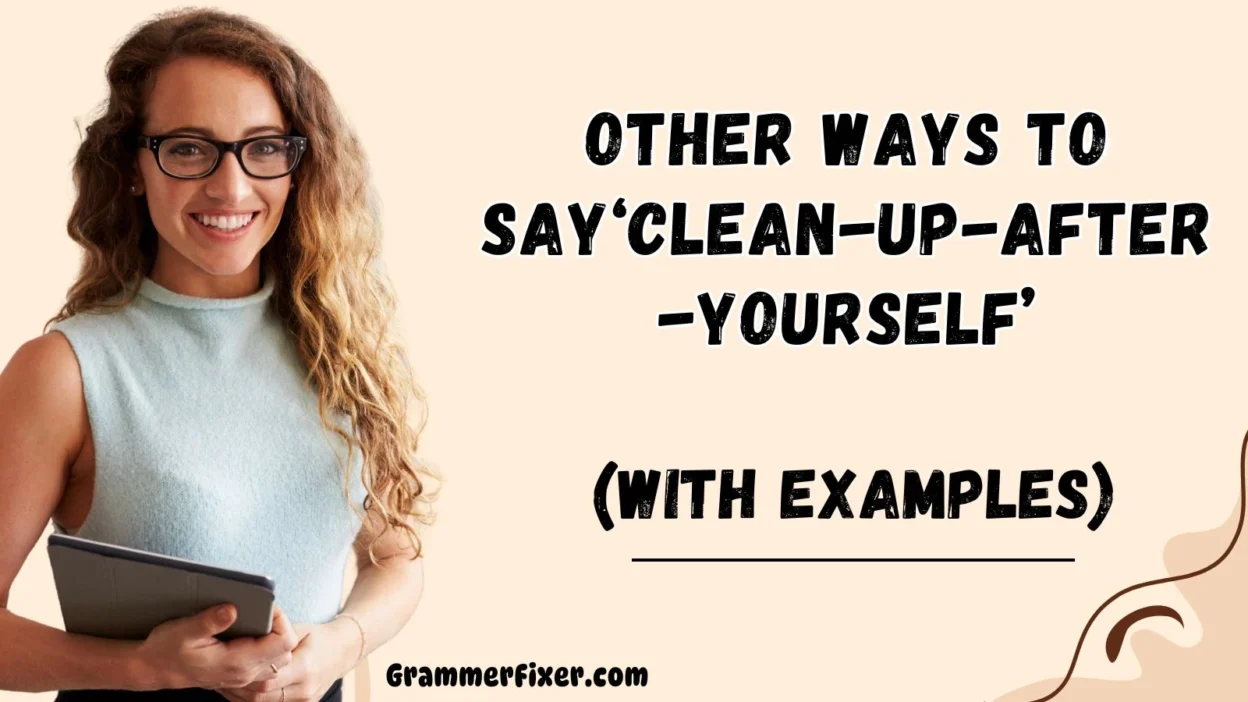Finding the right words to communicate care and responsibility can make a big difference in how your message is received. Saying “clean up after yourself” doesn’t always have to sound direct or harsh. With thoughtful alternatives, you can encourage tidiness, maintain harmony, and foster a sense of cooperation and respect—whether in an office, kitchen, classroom, or shared living space.
Below are 30 empathetic and polite ways to express this idea effectively.
What Does “Clean-Up-After-Yourself” Mean?
“Clean-up-after-yourself” means taking responsibility for your own mess, whether that’s putting away items, wiping surfaces, or restoring a shared space to its original condition.
It emphasizes personal accountability and consideration for others who use the same environment.
Is It Professional/Polite to Say “Clean-Up-After-Yourself”?
Directly saying “clean up after yourself” can come across as blunt or commanding.
In professional and social settings, using polite phrasing, gentle reminders, or inclusive language helps communicate the expectation while maintaining respect and collaboration.
Advantages and Disadvantages of Using Alternatives to “Clean-Up-After-Yourself”
Advantages
- Promotes a Positive Tone – Alternatives allow you to communicate responsibility and tidiness without sounding harsh or demanding, fostering a respectful and friendly environment.
- Encourages Cooperation – Phrases like “Let’s keep this space neat” or “Help maintain cleanliness” invite teamwork and shared responsibility, improving collaboration among coworkers, peers, or family members.
- Enhances Professionalism – Using polite, considerate language is suitable for offices, meetings, and professional settings, maintaining a culture of respect and accountability.
- Reduces Conflicts – Thoughtful phrasing decreases defensiveness or resentment that can arise from blunt commands, creating a harmonious atmosphere.
- Improves Organization and Productivity – Regularly encouraging tidiness helps maintain clutter-free spaces, allowing everyone to work or enjoy shared areas efficiently.
- Supports Hygiene and Safety – Phrases like “Please wipe down surfaces” reinforce cleanliness and well-being, which is particularly important in kitchens, cafeterias, or classrooms.
Disadvantages
- May Be Less Direct – Gentle alternatives can sometimes be too subtle, leading to the message being ignored or overlooked.
- Requires Consistency – To be effective, polite reminders must be used consistently; otherwise, shared spaces may remain untidy.
- Possible Misinterpretation – Some people may not recognize indirect phrasing as a request to act, requiring follow-ups or clarification.
- Time-Consuming – Crafting thoughtful, empathetic messages can take more time than a direct command, especially in busy professional settings.
- Not Suitable for Urgent Situations – In cases where immediate cleanup is needed (e.g., spills or safety hazards), gentle phrasing may delay action compared to direct instructions.
1. Please Tidy Up Your Area
Meaning: A polite way to ask someone to organize their personal space.
Explanation: Focuses on encouraging cleanliness without sounding harsh.
Scenario Example: “Hey Alex, could you please tidy up your desk before leaving?”
Best Use: Offices, classrooms, shared workspaces.
Tone: Polite, gentle, considerate.
2. Would You Mind Helping Maintain the Space?
Meaning: Invites participation in keeping a shared environment clean.
Explanation: Encourages collaboration and shared responsibility.
Scenario Example: “Hi team, would you mind helping maintain the kitchen area after lunch?”
Best Use: Teamwork-focused environments.
Tone: Inclusive, cooperative, respectful.
3. Kindly Restore Things to Their Original Place
Meaning: Suggests returning items to their designated spots.
Explanation: Emphasizes organization and orderliness rather than pointing out mess.
Scenario Example: “Emily, could you kindly restore the office supplies to their original place?”
Best Use: Offices, libraries, classrooms.
Tone: Courteous, thoughtful, professional.
4. Ensure Everything Is Put Away
Meaning: Reminds someone to store items properly after use.
Explanation: Clear, action-oriented, and emphasizes responsibility.
Scenario Example: “Please ensure everything is put away before the end of the meeting.”
Best Use: Workspaces, project areas.
Tone: Direct but polite, professional.
5. Let’s Keep This Space Neat
Meaning: Encourages maintaining a tidy environment collectively.
Explanation: Uses inclusive “let’s” to soften the directive and promote cooperation.
Scenario Example: “Let’s keep this break room neat so everyone enjoys it.”
Best Use: Communal areas, team gatherings.
Tone: Friendly, inviting, collaborative.
6. Please Wipe Down Surfaces After Use
Meaning: Suggests cleaning shared surfaces to maintain hygiene.
Explanation: Focuses on health and cleanliness rather than personal fault.
Scenario Example: “Morning everyone, please wipe down surfaces after finishing your coffee.”
Best Use: Offices, kitchens, classrooms.
Tone: Polite, professional, caring.
7. Take a Moment to Organize Your Area
Meaning: A gentle reminder to tidy up after finishing tasks.
Explanation: Encourages mindfulness and personal responsibility without sounding critical.
Scenario Example: “Hey Chris, take a moment to organize your area before leaving.”
Best Use: Offices, workshops, classrooms.
Tone: Supportive, friendly, empathetic.
8. Would You Mind Putting Things Back?
Meaning: Requests returning items to their proper location.
Explanation: Makes the instruction less authoritative by phrasing as a question.
Scenario Example: “Morgan, would you mind putting the chairs back after the meeting?”
Best Use: Team environments, shared spaces.
Tone: Gentle, considerate, polite.
9. Please Keep the Workspace Orderly
Meaning: Encourages maintaining an organized environment.
Explanation: Highlights the value of order for productivity and focus.
Scenario Example: “Please keep the workspace orderly to ensure smooth operations.”
Best Use: Professional offices, project areas.
Tone: Formal, clear, polite.
10. Double-Check Your Area Before You Go
Meaning: Reminds individuals to make sure nothing is left behind.
Explanation: Adds an extra layer of responsibility without sounding critical.
Scenario Example: “Before leaving, please double-check your area for any personal items.”
Best Use: Offices, classrooms, shared spaces.
Tone: Considerate, professional, attentive.
11. Keep Things in Their Place
Meaning: Encourages putting items back where they belong.
Explanation: Focuses on organization and respect for shared spaces.
Scenario Example: “Hey team, please keep things in their place after using the meeting room.”
Best Use: Offices, kitchens, classrooms.
Tone: Friendly, polite, supportive.
12. Put Away Your Belongings
Meaning: Requests storing personal or shared items properly.
Explanation: Clear and actionable while remaining considerate.
Scenario Example: “Before leaving, kindly put away your belongings to keep the room tidy.”
Best Use: Shared workspaces, classrooms, kitchens.
Tone: Direct but courteous, professional.
13. Organize Your Desk/Area
Meaning: Encourages neatness and personal responsibility.
Explanation: Promotes tidiness and productivity by creating a clutter-free space.
Scenario Example: “Emily, please organize your desk to make it easier for the next person.”
Best Use: Offices, workstations, study areas.
Tone: Polite, professional, constructive.
14. Clear Your Space
Meaning: Requests removing clutter and restoring order.
Explanation: A concise and gentle directive suitable for busy environments.
Scenario Example: “Before the next session, please clear your space so others can use it comfortably.”
Best Use: Classrooms, conference rooms, cafeterias.
Tone: Direct, courteous, professional.
15. Put Everything Back
Meaning: Ensures items are returned to their designated spots.
Explanation: Highlights responsibility and consideration for others.
Scenario Example: “Jordan, please put everything back after using the kitchen.”
Best Use: Communal spaces, offices, workshops.
Tone: Simple, polite, clear.
16. Restore the Area
Meaning: Requests returning a space to its original condition.
Explanation: Focuses on care, hygiene, and orderliness.
Scenario Example: “Hi Ava, kindly restore the area after your activity.”
Best Use: Event spaces, kitchens, classrooms.
Tone: Formal, courteous, professional.
17. Keep Your Area Spotless
Meaning: Encourages thorough cleaning and tidiness.
Explanation: Highlights the importance of hygiene and appearance.
Scenario Example: “Team, please keep your area spotless to maintain a pleasant workspace.”
Best Use: Offices, labs, shared kitchens.
Tone: Polite, motivational, encouraging.
18. Take Responsibility for Your Mess
Meaning: Reminds individuals to be accountable for their own items.
Explanation: Promotes personal responsibility without blaming others.
Scenario Example: “Hey Chris, please take responsibility for your mess in the break room.”
Best Use: Professional and casual settings.
Tone: Firm but polite, constructive.
19. Help Maintain Cleanliness
Meaning: Invites cooperation to keep the environment tidy.
Explanation: Focuses on teamwork and shared effort.
Scenario Example: “Hi everyone, let’s help maintain cleanliness in the kitchen.”
Best Use: Offices, cafeterias, shared spaces.
Tone: Collaborative, friendly, positive.
20. Make Sure Things Are Put Away
Meaning: Reminds individuals to properly store items after use.
Explanation: Emphasizes order and accountability without being harsh.
Scenario Example: “Before leaving, make sure things are put away in their proper place.”
Best Use: Offices, classrooms, event spaces.
Tone: Direct, polite, professional.
21. Keep the Workspace Tidy
Meaning: Promotes maintaining an organized environment.
Explanation: Encourages neatness for productivity and morale.
Scenario Example: “Please keep the workspace tidy to make it enjoyable for everyone.”
Best Use: Offices, workshops, shared desks.
Tone: Friendly, polite, motivational.
22. Leave the Space as You Found It
Meaning: Suggests restoring the area to its previous condition.
Explanation: Focuses on respect and consideration for others.
Scenario Example: “Before leaving, please leave the space as you found it.”
Best Use: Offices, kitchens, conference rooms.
Tone: Polite, empathetic, thoughtful.
23. Straighten Things Up
Meaning: Encourages arranging items neatly.
Explanation: Casual and friendly approach to tidying.
Scenario Example: “Hey team, let’s straighten things up before the meeting.”
Best Use: Informal settings, shared areas.
Tone: Casual, conversational, gentle.
24. Take a Moment to Wipe Down
Meaning: Suggests cleaning surfaces after use.
Explanation: Focuses on hygiene and consideration for future users.
Scenario Example: “Before leaving, take a moment to wipe down the table.”
Best Use: Kitchens, classrooms, labs.
Tone: Polite, caring, professional.
25. Quick Cleanup, Please
Meaning: Requests a brief tidying effort.
Explanation: Friendly and approachable phrasing for minor messes.
Scenario Example: “Hey folks, quick cleanup, please, before heading out.”
Best Use: Casual offices, shared kitchens.
Tone: Light, friendly, inviting.
26. Make Sure Nothing Is Left Behind
Meaning: Reminds individuals to collect all personal or shared items.
Explanation: Clear instruction for accountability and order.
Scenario Example: “Please make sure nothing is left behind after using the conference room.”
Best Use: Offices, classrooms, event spaces.
Tone: Professional, polite, considerate.
27. Keep Shared Spaces Clean
Meaning: Encourages collective responsibility for tidiness.
Explanation: Focuses on respect and communal effort.
Scenario Example: “Everyone, please help keep shared spaces clean for the team’s comfort.”
Best Use: Workplaces, cafeterias, communal areas.
Tone: Inclusive, polite, empathetic.
28. Wrap Up Your Activity Neatly
Meaning: Suggests finishing tasks in an organized manner.
Explanation: Emphasizes thoroughness and responsibility for personal items.
Scenario Example: “Before leaving the craft room, wrap up your activity neatly.”
Best Use: Classrooms, workshops, studios.
Tone: Gentle, supportive, instructive.
29. Return Items to Their Proper Place
Meaning: Requests putting items back in designated spots.
Explanation: Highlights consideration for others and organizational habits.
Scenario Example: “Please return items to their proper place after use in the supply room.”
Best Use: Offices, libraries, classrooms.
Tone: Polite, professional, clear.
30. Help Keep the Environment Pleasant
Meaning: Encourages tidiness as part of creating a comfortable, welcoming space.
Explanation: Focuses on community, respect, and positive atmosphere rather than on blame.
Scenario Example: “Hi team, help keep the environment pleasant by tidying up after yourselves.”
Best Use: Offices, classrooms, kitchens, shared spaces.
Tone: Friendly, warm, inclusive.
Conclusion
Using alternatives to “clean up after yourself” allows you to communicate responsibility and tidiness with warmth and empathy. Whether in professional offices, shared kitchens, classrooms, or casual spaces, thoughtful phrasing helps maintain hygiene, order, and positive relationships. By choosing a polite, considerate, and collaborative tone, you not only encourage action but also promote a culture of respect, teamwork, and mindfulness.
Every phrase shared above is a tool to balance directness with empathy, ensuring your message is received as supportive rather than critical—making cleaning up a shared space a simple and pleasant part of daily life.
FAQs
1. Why should I use alternatives to “clean up after yourself”?
Using alternatives allows you to communicate responsibility and tidiness without sounding harsh or commanding. Thoughtful phrasing fosters respect, collaboration, and a positive environment in shared spaces like offices, kitchens, and classrooms.
2. Are these alternatives suitable for professional settings?
Yes! Many of the alternatives, such as “Please tidy up your area” or “Kindly restore things to their original place”, are polite, professional, and effective in workplace environments. The key is choosing a tone that balances directness with empathy.
3. Can these phrases be used with children or in casual settings?
Absolutely! Phrases like “Take a moment to organize your area” or “Wrap up your activity neatly” are friendly and gentle, making them suitable for children, family, or casual environments without sounding strict or authoritative.
4. How can I ensure my message is received positively?
Use a polite and inclusive tone, add context, and consider the audience. For example, saying “Let’s keep this space neat” encourages shared responsibility, while “Please wipe down surfaces” focuses on hygiene and consideration for others.
5. What are the benefits of using these alternatives regularly?
Consistently using empathetic and considerate phrasing:
- Maintains clean and organized spaces
- Encourages personal responsibility
- Reduces conflicts or resentment
- Creates a positive and welcoming atmosphere
- Improves collaboration and productivity



